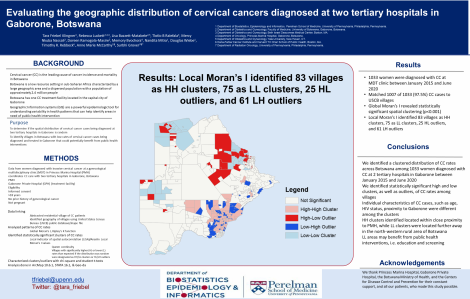Tara Friebel-Klingner
Spatial distribution of cervical cancer cases diagnosed in Gaborone, Botswana
Abstract
Background: Geographic Information systems (GIS) are a powerful tool for understanding health patterns that can help identify areas in need of public health intervention. This approach could particularly benefit Botswana, a low resource setting with high cervical cancer (CC) mortality characterized by a large geographic area and a dispersed population limited to one CC treatment facility located in Gaborone.
Methods: Merging publicly available geographic data together with CC residential data from a large cohort study at Princess Marina Hospital (PMH) in Gaborone, we aimed to identify geographic patterns of CC cases using Global Moran’s I and Anselin Local Moran’s I values (ArcMap 10.6.1), to test if the spatial distribution of CC rates was random. Villages with significantly higher (H) or lower (L) rates than expected were designated as HH/LL clusters or HL/LH outliers. Chi-square tests and t-tests identified differences among the clusters/outliers.
Results: There were 1033 women were diagnosed with CC at PMH between 2015 and 2020. We identified a non-random distribution of CC rates across Botswana (p <0.001). Local Moran’s I identified 83 HH clusters, 75 LL clusters, 25 HL outliers, and 61 LH outliers. Individual characteristics of CC cases such as age, HIV status, and proximity to PMH were different among the clusters.
Conclusions: We identified non-random patterns of CC rates throughout Botswana. Importantly, high and low clusters could help identify areas for implementing public health interventions, i.e. screening programs. Next steps will be to assess CC knowledge, screening and healthcare systems in these villages.
Keywords
GIS, spatial analysis, cervical cancer, global health, BotswanaCommenting is now closed.
About Us
To understand health and disease today, we need new thinking and novel science —the kind we create when multiple disciplines work together from the ground up. That is why this department has put forward a bold vision in population-health science: a single academic home for biostatistics, epidemiology and informatics.
© 2023 Trustees of the University of Pennsylvania. All rights reserved.. | Disclaimer




Comments